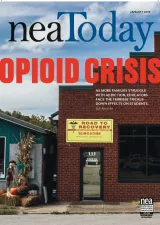It’s one of the critical issues that the #RedForEd movement brought to the nation’s attention: Lawmakers have chronically underfunded our schools. As a result too many educators and students are stuck in deteriorating school buildings where they face problems ranging from unpleasant to outright hazardous.
In some schools, the heat goes out and students sit in frigid classrooms in their coats, hats, and gloves. Elsewhere, a leaky roof means buckets in the hallways and classroom, and moldy ceiling tiles that pose a health risk—especially for those with respiratory issues.
Some problems with old buildings are less obvious but just as serious, including asbestos, radon, and old pipes and water fountains that contain lead.
“If we’re committed to helping every child fulfill his or her potential, then we have to provide safe and modern learning environments for every student,” says Oregon teacher and parent activist Carolyn Smith Evans, who serves on the board of the Healthy Schools Network.
As if we need another reason to renovate and modernize schools. Underfunded school infrastructure also leaves some students without the technology they need to prepare for college and jobs. At least 6 million students—mostly in rural communities—attend schools that lack highspeed internet access.
Click to Enlarge




